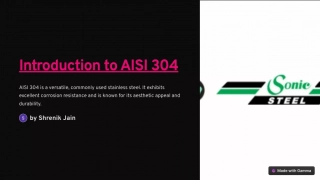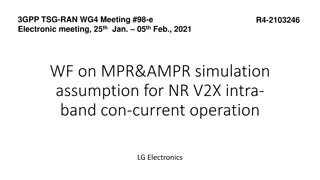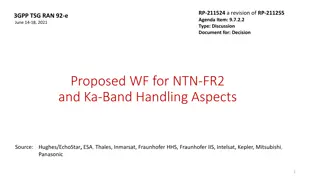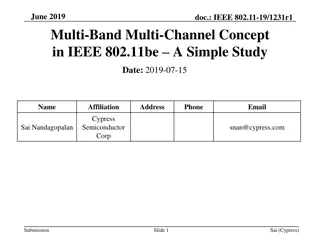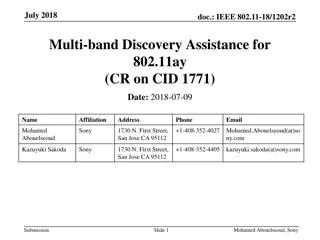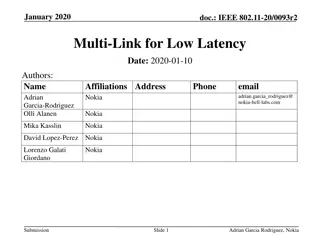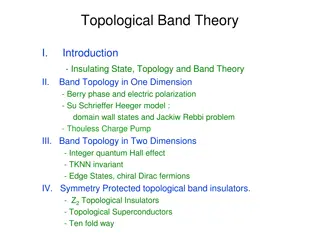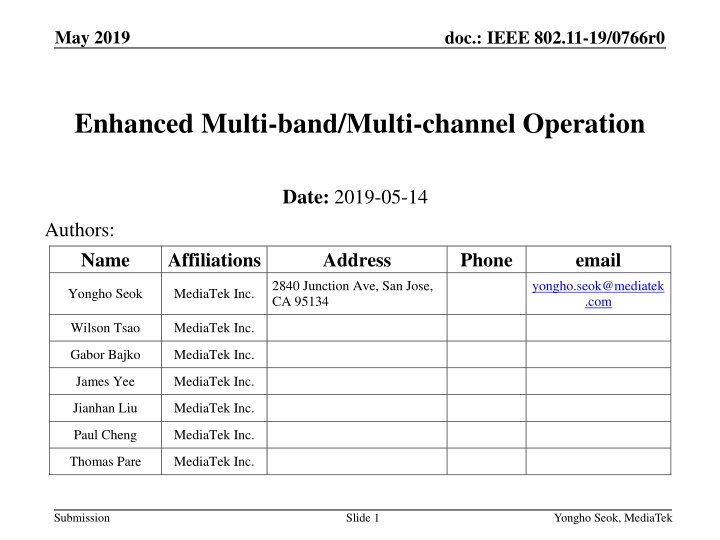
Enhanced Multi-band Multi-channel Operation Analysis for EHT Program
Explore the benefits of multi-band/multi-channel operation in meeting the high throughput and real-time requirements of EHT applications like 4k/8k video, virtual reality, gaming, and cloud computing. Understand the functional requirements and potential improvements in per-session throughput and latency by utilizing multiple bands/channels simultaneously.
Download Presentation

Please find below an Image/Link to download the presentation.
The content on the website is provided AS IS for your information and personal use only. It may not be sold, licensed, or shared on other websites without obtaining consent from the author. If you encounter any issues during the download, it is possible that the publisher has removed the file from their server.
You are allowed to download the files provided on this website for personal or commercial use, subject to the condition that they are used lawfully. All files are the property of their respective owners.
The content on the website is provided AS IS for your information and personal use only. It may not be sold, licensed, or shared on other websites without obtaining consent from the author.
E N D
Presentation Transcript
May 2019 doc.: IEEE 802.11-19/0766r0 Enhanced Multi-band/Multi-channel Operation Date: 2019-05-14 Authors: Name Affiliations Address Phone email 2840 Junction Ave, San Jose, CA 95134 yongho.seok@mediatek .com Yongho Seok MediaTek Inc. Wilson Tsao MediaTek Inc. Gabor Bajko MediaTek Inc. James Yee MediaTek Inc. Jianhan Liu MediaTek Inc. Paul Cheng MediaTek Inc. Thomas Pare MediaTek Inc. Submission Slide 1 Yongho Seok, MediaTek
May 2019 doc.: IEEE 802.11-19/0766r0 Outline As described in the EHT PAR, one of the needs of the EHT program is to provide the high throughput and meet stringent real-time delay requirements of 4k and 8k video, virtual reality or augmented reality, gaming, remote office and cloud computing applications. In this presentation, we have analyzed how the EHT multi-band/multi-channel operation can be helpful to meet those PAR requirements. Submission Slide 2 Yongho Seok, MediaTek
May 2019 doc.: IEEE 802.11-19/0766r0 EHT Multi-band/Multi-channel Functional Requirement In a legacy multi-band and multi-channel operation (e.g., FST), sessions of an individual STA can be transferred from a channel to another channel, in the same or different frequency bands. But, a limitation is that MSDUs belonging to single TID can only use single bands and/or channels. Submission Slide 3 Yongho Seok, MediaTek
May 2019 doc.: IEEE 802.11-19/0766r0 EHT Multi-band/Multi-channel Functional Requirement As discussed in [1], if a STA can simultaneously use the multiple bands and/or channels, per-session throughput and per-session latency can be significantly improved. Because MSDUs belonging to single session (e.g., TID) can be sent on multiple bands and/or channels simultaneously. Submission Slide 4 Yongho Seok, MediaTek
May 2019 doc.: IEEE 802.11-19/0766r0 EHT Multi-band/Multi-channel Functional Requirement A STA may perform a channel access on multiple bands and/or channels independently. When the STA obtains TXOPs on multiple bands and/or channels, it can send frames belonging to same TID over multiple links simultaneously. Data [Seq4, TID1] Data [Seq3, TID1] AP 6GHz STA Block ACK backoff Data [Seq5, TID1] Data [Seq2, TID1] Data [Seq1, TID1] AP 5GHz STA Block ACK Submission Slide 5 Yongho Seok, MediaTek
May 2019 doc.: IEEE 802.11-19/0766r0 EHT Multi-band/Multi-channel Functional Requirement But, if the STA has an in-device coexistence interference on multiple bands and/or channels, it may not transmit and receive frames simultaneously. In such a case, the STA needs to coordinate and synchronize the transmission and reception timing over bands and/or channels. backoff Data [Seq3, TID1] Data [Seq4, TID1] Data [Seq6, TID1] AP 6GHz STA Block ACK backoff Data [Seq5, TID1] Data [Seq2, TID1] Data [Seq1, TID1] AP 5GHz STA Block ACK Submission Slide 6 Yongho Seok, MediaTek
May 2019 doc.: IEEE 802.11-19/0766r0 EHT Multi-band/Multi-channel Functional Requirement In this operation, the STA should access multiple bands and/or channels without additional protocol overhead. With legacy FST, when switching sessions, the SME of the STA needs to initiate the FST Setup Request and Response frame exchanges as well as the FST Ack Request and Response frame exchanges. Also, control information (e.g., control frames, A- Control fields) for a channel can be transmitted in a different channel/band. Allowing out-of-band exchange of control information can result in more efficient allocation of resources. Submission Slide 7 Yongho Seok, MediaTek
May 2019 doc.: IEEE 802.11-19/0766r0 Performance Evaluation via Simulation Throughput comparison between single band operation (legacy) and multi-band operation AP STA Single-band (Legacy) Link 1/5GHz Link 1/5GHz Link 2/6GHz Multi-band AP STA Submission Slide 8 Yongho Seok, MediaTek
May 2019 doc.: IEEE 802.11-19/0766r0 Performance Evaluation via Simulation Async Operation Busy Link 1/5GHz Busy Link 2/6GHz Single primary channel (on Link 1) Sync Operation Busy Busy Link 1/5GHz Link 2/6GHz Dual primary channels (on Link 1 and Link 2) Sync Operation Link 1/5GHz Busy Busy Link 2/6GHz Submission Slide 9 Yongho Seok, MediaTek
May 2019 doc.: IEEE 802.11-19/0766r0 Simulation Setup Simulation Parameters: Bandwidth: 80 MHz MCS: 9 (453.7 Mbps) Full buffer DL UDP traffic. Busy percentage: Percentage of Link 2/6GHz air time occupied by OBSS activities on Link 1/5GHz. Submission Slide 10 Yongho Seok, MediaTek
May 2019 doc.: IEEE 802.11-19/0766r0 Performance Evaluation via Simulation Submission Slide 11 Yongho Seok, MediaTek
May 2019 doc.: IEEE 802.11-19/0766r0 Conclusion In this contribution we discuss the limitations of legacy multi-band/multi-channel operation and the desired EHT multi-band/multi-channel function requirements. Key improvement should be that a STA can transmit frames of same TID or different TIDs over multiple bands and/or channels concurrently or non-concurrently. Via Simulation, showed that it is possible for multi- band/multi-channel operation (synchronous and asynchronous) to achieve significant performance enhancements under heavy interference. Submission Slide 12 Yongho Seok, MediaTek
May 2019 doc.: IEEE 802.11-19/0766r0 Reference [1] https://mentor.ieee.org/802.11/dcn/18/11-18-1155-01- 0eht-multi-ap-enhancement-and-multi-band- operations.pptx Submission Slide 13 Yongho Seok, MediaTek


